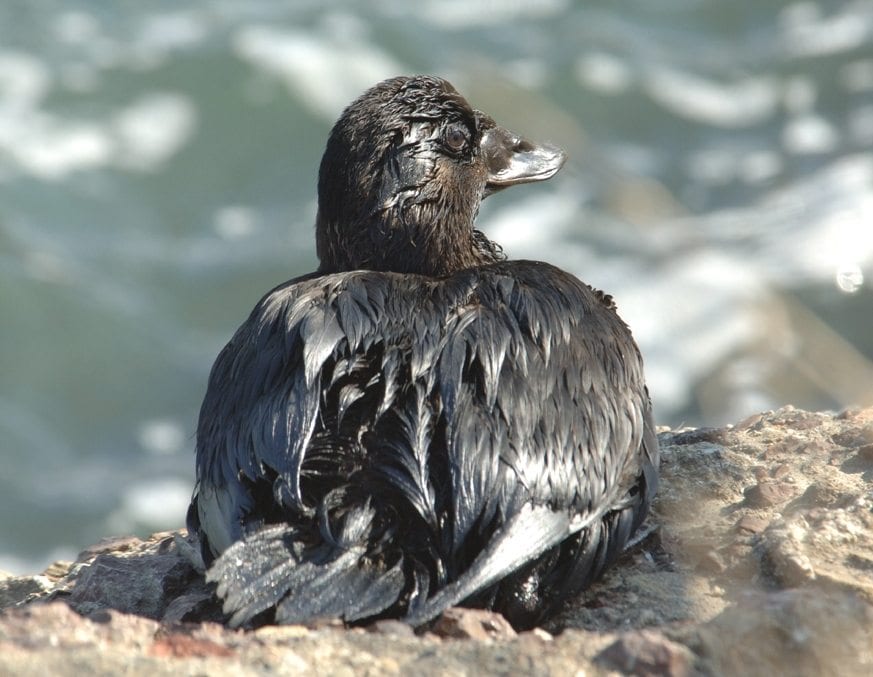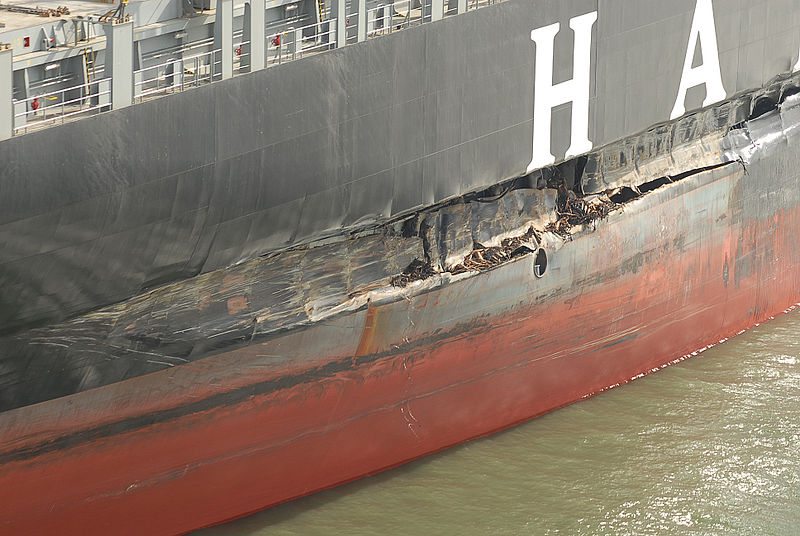Cosco Busan oil spill – 10 years later
By Ilana DeBare
Ten years ago — on November 7, 2007 — the Cosco Busan container ship struck a tower supporting the Bay Bridge and released 54,000 gallons of fuel into San Francisco Bay.
The spill was disastrous for wildlife, killing thousands of birds and blackening shorelines throughout the region.
Golden Gate Bird Alliance played a leading role in documenting the damage, mobilizing 250 volunteers to conduct bird surveys in the days after the spill. Through the incident, GGBA and its partner organizations learned some valuable lessons in how to respond to spills.
But the bigger lessons of the Cosco Busan are sobering and have not yet been taken to heart by our country’s leaders.
“If there’s anything we learned ten years ago in San Francisco Bay, it’s that one small mistake can quickly kill a lot of birds and destroy places we care about deeply,” said Andrea Jones, Director of Bird Conservation for Audubon California. “Now that the federal government is pushing for new drilling, it’s important to remember what’s at risk.”

The anniversary of San Francisco Bay’s worst oil spill comes as the Trump Administration pushes for increased oil drilling off the California coast. At the president’s direction, the Commerce Department just completed a report outlining potential changes to allow oil drilling within national marine sanctuaries – including the Greater Farallones National Marine Sanctuary just off the Golden Gate Bridge. The Department of Interior is currently studying removing restrictions on new offshore drilling on the outer continental shelf.
The 2007 spill by the 900-foot Cosco Busan affected people, estuarine and marine wildlife, habitats, the fishing industry, and recreation across several counties. It happened in the middle of winter migration, the worst time and the worst place imaginable. Millions of waterbirds were arriving from the Arctic and Boreal forests to either winter here or rest during their southward migration – only to encounter oily water.


San Francisco Bay has been designated an Important Bird Area of Global Significance by Audubon because it hosts well over a million birds annually and has some of the last remaining wetlands in California. It is host to the largest shorebird concentration on the US Pacific Coast.
“Almost immediately following the spill, there were reports of dead and dying birds in the Bay,” said Jones. “Although the impacts of any oil spills are broad, images of dead birds are almost always the first and most enduring image of these disasters.”
Oil spills are particularly hazardous for birds because oiled feathers lose their ability to insulate.
“Birds lose their ability to thermoregulate, so they’re exposed to the cold and wet and can succumb to the elements,” said Noreen Weeden, GGBA’s Director of Volunteers. “Plus sometime they ingest it when trying to clean themselves off. Bunker fuel is the really dirty part of fuel, and they were consuming that.”

In the days following the spill, GGBA members sprang into action. Weeden worked with members Eddie Bartley and Dan Murphy to develop a field data form, and 250 volunteers started shoreline surveys in four counties two days after the spill.
“People were calling our office and asking, ‘What can we do,’” Weeden said. “We wanted to contribute where we have skills, and our members have bird ID skills and a knowledge of what is normal and abnormal bird behavior.”
Over a period of nine weeks, GGBA surveyors counted 2,207 oiled birds and 102 dead birds, represented by 70 different species and/or groups of species. Approximately 60 percent of all oiled birds observed were diving birds, 25 percent were gulls, 12 percent were waders, and three percent were dabbling ducks.
Those numbers were only a tiny part of the picture, though. State and federal agencies estimated that over 6,000 birds were killed. About 200 miles of coastline were oiled. Herring eggs were killed in areas affected by the spill, and an estimated 14 to 29 percent of the herring spawn that winter were lost.
The GGBA survey volunteers immediately reported the oiled birds they found, which allowed trained wildlife rescuers from groups like International Bird Rescue to retrieve them. In the longer run, GGBA survey data became part of the documentation used by government agencies in determining the fine to be paid by Cosco Busan owners.
The Cosco Busan disaster did lead to some positive developments. In response to the widespread confusion about how to respond to the spill, a formal Incident Command Structure was created by the Coast Guard and other agencies, which will assess risks and create an action plan in future spills.
More individuals and wildlife organizations including GGBA joined the Oiled Wildlife Care Network, which holds annual trainings in how to rescue oiled birds. Golden Gate Bird Alliance also developed its own internal emergency response plan, which addresses threats like earthquakes as well as oil spills.
Meanwhile, staff at Audubon California’s Richardson Bay nature sanctuary in Marin County noticed that many birds were using barren Arambaru Island as a refuge from the toxic waters. That led to a project to turn the island, owned by the county, into bird habitat. Oil spill reparations helped fund creation of a suite of habitats there that was completed in 2012.
On a broader level, though, the most important lessons have not been learned. Our coastal waters and shoreline are precious for wildlife, people, and our economy. We can not afford to risk them through unnecessary and dangerous oil drilling.
Are you interested in become a trained rescue volunteer through the Oiled Wildlife Care Network? There’s an all-day training in Milpitas on December 5. Contact Noreen at nweeden@goldengatebirdalliance.org for information.
Click here for more information on the Trump Administration threat to our offshore marine sanctuaries, including the Greater Farallones sanctuary.
Thank you to Garrison Frost and Audubon California for contributing to this blog post.
